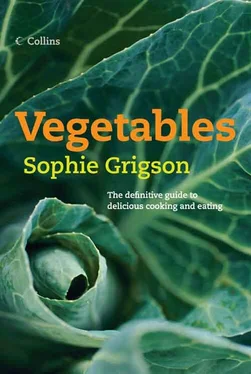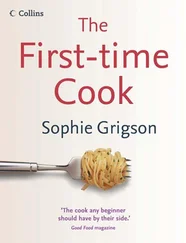Peppery mashed swede and carrot
This is the dish that my guides Jess and Jennine insisted that I should include. They were not in total agreement as to the details, but the main theme was much the same. It is good, I have to admit, as long as there is plenty of butter mashed roughly into the swede, along with terrific quantities of freshly ground black pepper.
Although it goes against my every instinct, I followed Jess’s instructions to cook swede and carrot for an extraordinary 40–60 minutes. It turns out that she is right, as it gives a rough mash that is tender but still not totally devoid of texture. The ratio of carrot to swede is another personal foible. You might like to increase the carrot to 50 per cent of the total.
Incidentally, if you replace the carrot with potato (roughly equal quantities with the swede) and add a quartered onion to the pan too, what you end up with is Orkney clapshot.
Serves 6
1 swede, weighing about 675 g (11/2 lb), peeled and cut into 2 cm cubes
about 250g (8 oz) carrots, thickly sliced
60 g (2 oz) butter
salt and ginormous amounts of freshly ground black pepper
Bring a pan of unsalted water to the boil and add the swede and carrots. Turn down the heat to give a pleasantly slow simmer, then walk away and forget about the vegetables for at least 40 minutes, and up to an hour. Actually, don’t ignore them totally – you’ll need to check every now and then that the water level hasn’t dropped down too low. If it is disarmingly low, top up with more boiling water.
When both vegetables are terrifically soft, drain them well and return to the pan along with the butter, salt and lots and lots and lots of freshly ground black pepper. Mash the whole lot together, taste and adjust seasoning, and serve swiftly
Bashed neeps is a variable dish. On an average day it is just mashed ‘neeps’ with butter and pepper, and is what posher people might once have called ‘turnip purry’. On high days and holidays, however, cream comes into play along with a generous slug of whisky for those who fancy it.
Serves 6–8
2 swedes, peeled, cubed and boiled until tender
30g (1 oz) butter
80 ml (3 floz) double cream
2 tablespoons whisky
3 tablespoons chopped chives
salt and pepper
Drain the swedes thoroughly, then return to the pan with the butter, cream and generous quantities of seasoning. Mash together roughly over a gentle heat until piping hot. Stir in the whisky and most of the chives. Taste and adjust seasoning, then serve with the remaining chives sprinkled over the top.
From the south of the country comes one of the finest of recipes embracing swede. I’m not for one moment saying that this is a definitive recipe for a Cornish pasty, but it is something close, with fine steak baked slowly on top of a thin layer of swede and potato. This vegetable layer is essential to soak up the juices from the meat, keeping the pastry crisp on the bottom.
Makes 4
Pastry
500g (1 lb 2oz) plain flour
a pinch of salt
160 g (51/2 oz) butter
60g (2oz) lard
icy water
1 egg yolk, beaten, to glaze
Filling
500g (1 lb 2oz) rump steak, cut into small cubes
1 onion, chopped
1 large potato, peeled and very thinly sliced
1 small swede, peeled and very thinly sliced
salt and pepper
To make the pastry, mix the flour with the salt. Rub in the butter and lard, then add just enough water to mix to a soft but not sticky dough. Wrap in foil or clingfilm and chill for at least half an hour. Bring back to just under room temperature before rolling out.
Mix the steak with the onion and plenty of seasoning. Line a baking sheet with non-stick baking parchment. Divide the pastry into four, and roll out each piece large enough to cut out a 20cm (8in) circle (use a side plate as a template).
Arrange one-quarter of the potato in the centre of each pastry circle in an oval shape and season. Lay one-quarter of the swede over that, then mound a quarter of the steak mixture over that, moulding it to cover the potato. Dampen the edges around one half of each pastry circle with a little of the egg glaze, then bring both sides up over the filling, crimping the edges firmly together to form the characteristic pasty shape. Rest in the fridge for half an hour.
Preheat the oven to 220°C/425°F/Gas 7. Brush the pasties with egg glaze, then bake for 15 minutes. Reduce the heat to a lowly 170°C/325°F/Gas 3 and leave the pasties to bake for a further hour. Check regularly and cover with foil if the pastry is browning too rapidly. Serve hot, warm or cold.
It’s the colour that does it for me, every time. It’s so damn cheery. Brighter than even a carrot; it’s that orange. Not on the outside, of course. No, the skin of a sweet potato is a muted, more sophisticated wine-dregs rose. Remarkably similar, if not identical, to the skin of a kumara (see page 46), the white-fleshed form of the sweet potato, which would be confusing if kumara were more commonly available.
The vibrant orange of the flesh of the sweet potato only develops as the tuber cooks. Raw, the colour of the flesh sends me back to a time when junior aspirins were coloured just that attractive shade of faded, pinky orange. You can, I am assured, eat sweet potatoes raw – grated perhaps into a salad – but I’ve tried it and I don’t think I’ll bother again. The moistness of the sweet cooked flesh, with its psychedelic-sweetie hue, is what appeals.
Despite the obvious allure of the sweet potato, it has taken an awfully long time to make headway on this side of the Atlantic. It came back from the Americas with the Spanish Conquistadors, and indeed the very first potato of any kind to be planted on our shores is rumoured to have been an Ipomoea batatas , not a true potato ( Solanum tuberosum ) at all. They are not, incidentally, even vaguely related, belonging to different botanical families. Unlike real potatoes, sweet potatoes crave warmth and without it they won’t thrive; England’s climate is hardly sub-tropical, and the crop was a miserable failure.
Now we’ve given up growing them in the great outdoors, and finally are importing them in increasing numbers. Sales are swelling, we are slowly taking them to our hearts, and they look like becoming a permanent fixture in the British diet. Hurrah. It’s only taken 500 years.
Taut skin and firm bodies – that’s what you’re looking for, just like on the
beach. At the risk of sounding ageist, wrinkles are to be rejected, and there’s no point at all in handing over your cash for a sweet potato that has soft patches. The tips may be slightly discoloured but this is only to be expected – those sweet potatoes have travelled a long way. If I have a choice I pick larger tubers, merely because they are less fiddly to handle.
Stored in a cool place they will last for several weeks, but like most vegetables the sooner you cook them the better they will taste.
I’ll bet you a tenner that most of the sweet potatoes eaten here are bakedin their jackets. It’s the obvious way to cook a sweet potato. None of that sweetness leaching out, and no extra damp creeping in. It makes sense. Treat them just like ordinary potatoes – prick the skin, rub in a little salt if you wish, then bake at around 190°C/375°F/Gas 5 until tender. Time will depend on the size of the potatoes, but we’re talking in terms of 45–60 minutes, give or take. Or microwave them, again just as you would an ordinary potato.
Читать дальше












